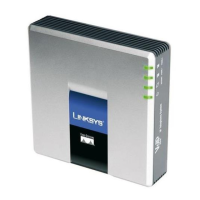Linksys Voice System Administration Guide 42
Network Address Translation (NAT) and Voice over IP (VoIP)
Configuring the SPA9000 for ITSP Interoperability
SPA9000 Voice > SIP: NAT Support Parameters
4. Click Voice tab > Line N, where N is the number of the line interface for the ITSP service that
you need to configure.
5. Scroll down to the NAT Settings section.
• NAT Mapping Enable: Choose YES.
• NAT Keep Alive Enable: Choose YES (optional).
NOTE: Your ITSP may require the SPA9000 to send NAT keep alive messages to keep the
NAT ports open permanently. For more information, see Appendix A, "Advanced Topics
in LVS Administration," ”SIP-NAT Interoperation” section on page 135.
6. Click Submit All Changes.
NOTE: You also need to configure the firewall settings on your router to allow SIP traffic. See
”Firewalls and SIP,” on page 43.
Configuring NAT Mapping with STUN
Configuring NAT mapping in the SPA9000 is recommended only if the ITSP network does not
provide a Session Border Controller functionality. In this case, and if the external (Public) IP
address is assigned dynamically by the network (and the router uses asymmetric NAT
mechanism), it is possible to use STUN as a mechanism to discover the NAT mapping in
SPA9000. This is considered a practice of last resort and should be used only if the other
methods are unavailable.
Note STUN is a viable option only if your router uses asymmetric NAT. See
Appendix A, "Advanced Topics in LVS Administration," ”Determining
Whether the Router Uses Symmetric or Asymmetric NAT” section on
page 136.
1. Connect to the SPA9000 administration web server, and choose Admin access with
Advanced settings. (See ”Connecting to the SPA9000 Administration Web Server,” on
page 24.)
2. Click Voice tab > SIP.

